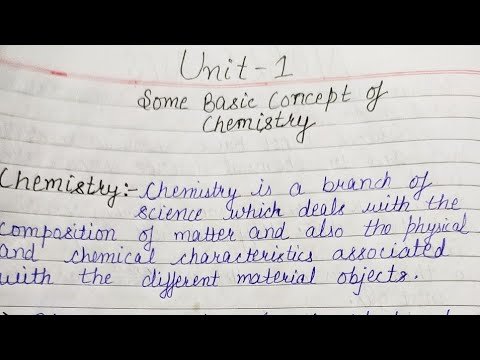
1. Introduction to Chapter 1 Notes on Some Basic Concepts of Chemistry Class 11 Chemistry Chapter 1 Notes
Class 11 Chemistry Chapter 1 Notes, provide a foundational understanding of chemistry’s basic principles. It defines chemistry as the study of different substances and their transformations. The chapter begins with a detailed exploration of matter, encompassing everything that occupies space and has mass.
2. Understanding Matter: Elements, Compounds, and Mixtures in Class 11 Chemistry Chapter 1 Notes
The Class 11 Chemistry Chapter 1 Notes elucidate various forms of matter: elements, compounds, and mixtures. It underscores the significance of these classifications in understanding chemical reactions and properties of substances.
3. Law of Conservation of Mass: Fundamental Principle Explained in Chapter 1 Notes on Some Basic Concepts of Chemistry
Chapter 1 Notes on Some Basic Concepts of Chemistry explain Antoine Lavoisier’s Law of Conservation of Mass, which asserts that the total mass of substances involved in a chemical reaction remains constant. This law serves as a cornerstone in understanding the quantitative aspects of chemical transformations.
4. Exploring the Concept of the Mole in Chapter 1 Notes on Some Basic Concepts of Chemistry
Chapter 1 Notes on Some Basic Concepts of Chemistry explore the concept of the mole, pivotal in quantitative chemistry, to measure the amount of substance. It facilitates precise calculations in chemical reactions, providing a link between atomic mass and macroscopic amounts of substances.
5. Laws of Chemical Combination: Key Principles Every Student Should Know from Class 11 Chemistry Chapter 1 Notes
The article delves into essential laws governing chemical combinations, as explained in Class 11 Chemistry Chapter 1 Notes:
- Law of Definite Proportions: Joseph Proust’s law stating that compounds contain fixed ratios of their constituent elements.
- Law of Multiple Proportions: John Dalton’s law illustrating the ratios in which elements combine to form multiple compounds.
- Gay-Lussac’s Law of Combining Volumes: Joseph Louis Gay-Lussac’s law describing the volumes of reactants and products in gaseous reactions.
- Avogadro’s Law: Amedeo Avogadro’s law relating the volume of gases to the number of molecules present, critical for understanding gas behavior.
6. Classification of Matter: Solids, Liquids, and Gases in Class 11 Chemistry Chapter 1 Notes
In Class 11 Chemistry Chapter 1 Notes, matter is classified into solids, liquids, and gases based on their physical properties and atomic arrangements. Each state is defined by unique characteristics impacting their behavior and interactions.
7. Properties of Matter: Physical and Chemical Properties Defined in Class 11 Chemistry Chapter 1 Notes
Class 11 Chemistry Chapter 1 Notes define properties of matter, such as physical properties (color, density, melting point) and chemical properties (reactivity, toxicity), which determine how substances interact with each other.
8. Measurement in Chemistry: Understanding Physical Quantities and SI Units in Class 11 Chemistry Chapter 1 Notes
Class 11 Chemistry Chapter 1 Notes emphasize measurement as fundamental in scientific inquiry. It details physical quantities and their SI units, providing a standardized framework for precision in scientific communication and experimentation.
9. Dalton’s Atomic Theory: Foundation of Modern Chemistry in Class 11 Chemistry Chapter 1 Notes
Class 11 Chemistry Chapter 1 Notes highlight John Dalton’s atomic theory, which revolutionized chemistry by proposing atoms as indivisible particles composing all matter. It also emphasizes fixed ratios in which atoms combine to form compounds, maintaining consistent proportions across different compounds.
10. Benefits of Class 11 Chemistry Chapter 1 Notes: Enhancing Conceptual Clarity
Class 11 Chemistry Chapter 1 Notes conclude by emphasizing their benefits:
- Conceptual Clarity: Simplifying complex topics like matter classification and chemical laws.
- Comprehensive Coverage: Ensuring all essential concepts are covered thoroughly.
- Exam Preparation: Facilitating easy revision with concise and well-organized content.
- Visual Learning Aids: Utilizing diagrams and illustrations to aid in understanding.
FAQs (Frequently Asked Questions)
How can I effectively use Class 11 Chemistry Chapter 1 Notes for exam preparation?
Class 11 Chemistry Chapter 1 Notes are designed to provide a comprehensive overview of fundamental concepts. Use them for regular revision and practice with related problems to reinforce your understanding.
Are Class 11 Chemistry Chapter 1 Notes suitable for competitive exam preparation?
Yes, these notes cover essential topics that are often part of competitive exams. However, supplement them with additional practice questions and mock tests specific to your exam format.
Can I rely solely on Class 11 Chemistry Chapter 1 Notes for exam preparation?
While Class 11 Chemistry Chapter 1 Notes offer a solid foundation, it’s recommended to use them alongside textbooks and reference materials to gain a deeper understanding and exposure to diverse problem-solving scenarios.
Where can I find visual aids mentioned in Class 11 Chemistry Chapter 1 Notes?
Visual aids such as diagrams and illustrations mentioned in Class 11 Chemistry Chapter 1 Notes can often be found in accompanying textbooks, online resources, or educational videos related to chemistry.
Conclusion
Class 11 Chemistry Chapter 1 Notes provide a robust foundation in the fundamental principles of chemistry. By mastering these concepts, students lay the groundwork for advanced studies and practical applications in the field of science.
